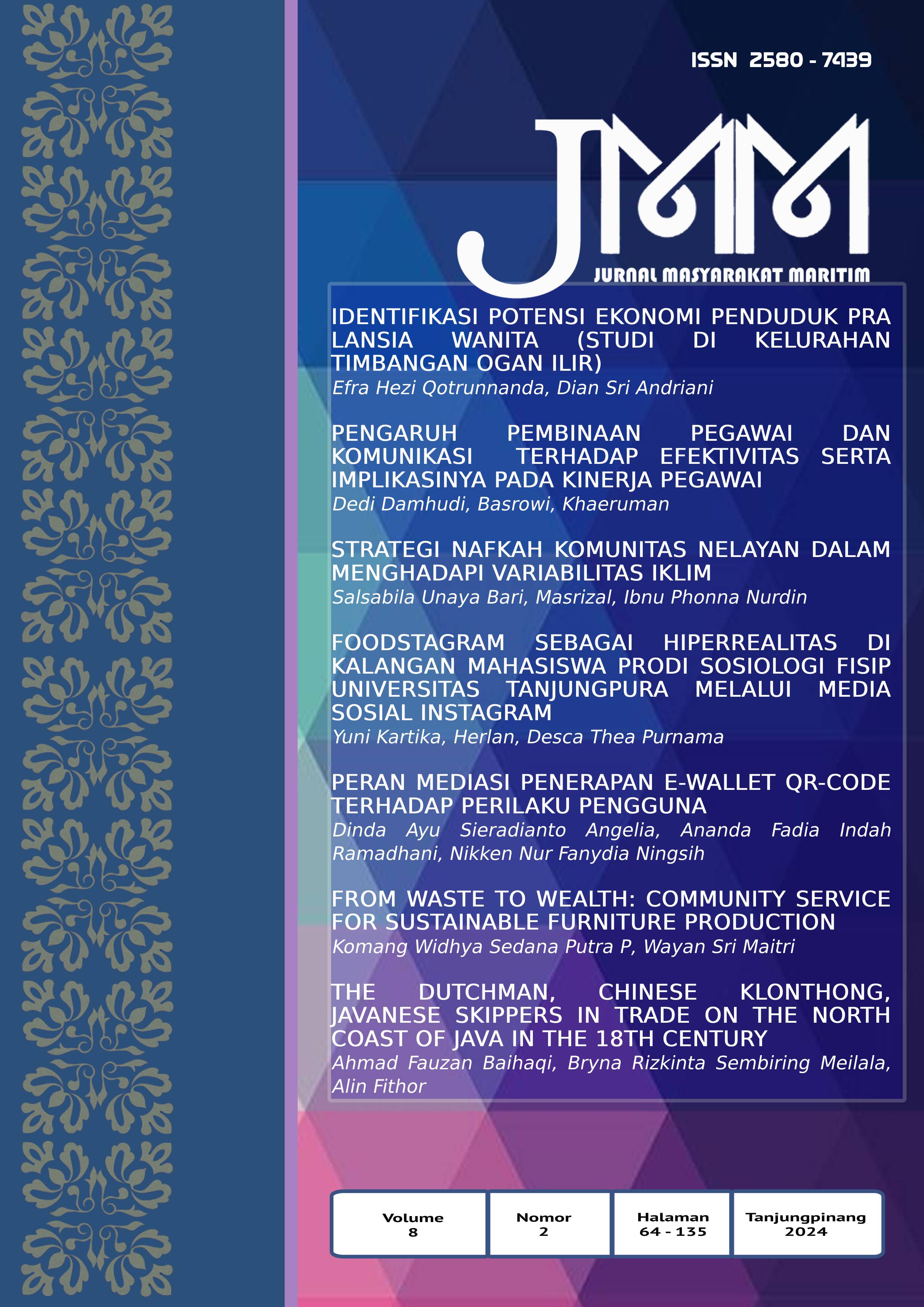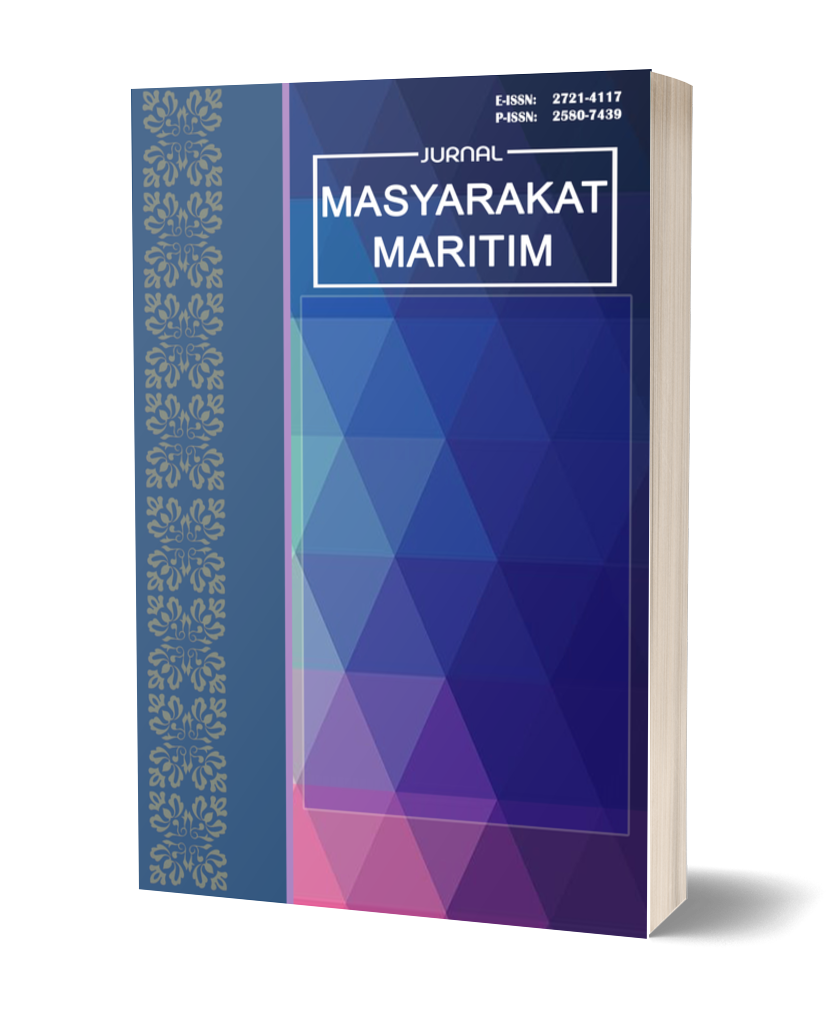PERAN MEDIASI PENERAPAN E-WALLET QR-CODE TERHADAP PERILAKU PENGGUNA
DOI:
https://doi.org/10.31629/jmm.v8i2.7042Keywords:
QR-Code, Adoption, BehaviourAbstract
Life continues to evolve in a more modern direction along with technological advancements. Digital transformation plays a crucial role in influencing consumer behavior and societal habits. In Indonesia, the financial sector leads in technological development, particularly in payment methods. The advancement of financial technology in Indonesia indicates that society has adapted and developed innovations in this field. In response to this growth, Bank Indonesia has introduced a policy to implement a single QR code that can be used across various payment applications, known as the Quick Response Indonesian Standard (QRIS). In payment methods, the QR Code functions as a connector between users and transaction services. One of the benefits of non-cash payment technology is improving the payment ecosystem and enhancing payment service efficiency across sectors. The objective of this study is to examine the mediating role of QR-Code E-Wallets on User Behavior. This research utilizes SmartPLS version 3.2 as an analytical tool, with SEM methodology and a quantitative survey technique. The findings indicate that performance expectancy, social influence, and hedonic motivation significantly influence the intention to use QR wallets. Additionally, performance expectancy and social influence have a positive and significant impact on User Behavior, while hedonic motivation has a positive but not significant effect on User Behavior. Furthermore, QR-Wallet intention can mediate the influence of hedonic motivation, performance expectancy, and social influence on User Behavior.
Downloads
References
Jurnal:
Adiyanta, F. C. S. (2019). Hukum dan Studi Penelitian Empiris : Penggunaan Metode Survey sebagai Instrumen Penelitian Hukum Empiris. Adminitrative Law & Governance Journal, 2(4), 697–709.
Ajzen, I. (2020). The theory of planned behavior: Frequently asked questions. Human Behavior and Emerging Technologies, 2(4), 314–324. https://doi.org/https://doi.org/10.1002/hbe2.195.
Ali, M. M., Hariyati, T., Pratiwi, M. Y., & Afifah, S. (2022). Metodologi Penelitian Kuantitatif Dan Penerapan Nya Dalam Penelitian. 2(2).
Amin, N. F., Garancang, S., & Abunawas, K. (2023). KONSEP UMUM POPULASI DAN SAMPEL DALAM PENELITIAN. Buku Ajar Statistika Dasar, 14(1), 15–31. https://doi.org/10.21070/2017/978-979-3401-73-7
Auliya, P. N., & Arransyah, M. F. (2023). Penerapan Model UTAUT untuk Mengetahui Minat Perilaku Konsumen dalam Penggunaan QRIS. Ekonomi, Keuangan, Investasi Dan Syariah (EKUITAS), 4(3), 885–892. https://doi.org/10.47065/ekuitas.v4i3.2808
Davis, F.D., Bagozzi, R.P. and Warshaw, P. R. (2020). User Acceptance of Computer Technology: A Comparison of Two Theoretical Models. Management Science, 8, 982-1002.
Ferdian, Y., Saputra, E., & Bahari, A. (2024a). Standard ( QRIS ) In Digital Payments Analisis Determinan Dan Anteseden Penggunaan Quick Response Indonesian Standard ( QRIS ) Pada Pembayaran Digital. Management Studies and Entrepreneurship Journal, 5(1), 3026–3037.
Ferdian, Y., Saputra, E., & Bahari, A. (2024b). Standard ( QRIS ) In Digital Payments Analisis Determinan Dan Anteseden Penggunaan Quick Response Indonesian Standard ( QRIS ) Pada Pembayaran Digital. Management Studies and Entrepreneurship Journal, 5(1), 3026–3037.
Ferial Tri Aura, Anwar, H., & Hamid, A. N. (2023a). Pengaruh Motivasi Hedonis Terhadap Impulsive Buying Pada Festival Belanja Tanggal Kembar. JMBI UNSRAT (Jurnal Ilmiah Manajemen Bisnis Dan Inovasi Universitas Sam Ratulangi)., 10(3), 2473–2484. https://doi.org/10.35794/jmbi.v10i3.53018
Ferial Tri Aura, Anwar, H., & Hamid, A. N. (2023b). Pengaruh Motivasi Hedonis Terhadap Impulsive Buying Pada Festival Belanja Tanggal Kembar. JMBI UNSRAT (Jurnal Ilmiah Manajemen Bisnis Dan Inovasi Universitas Sam Ratulangi)., 10(3), 2473–2484. https://doi.org/10.35794/jmbi.v10i3.53018
Ghozali, I. (2021). Aplikasi Analisis Multivariate Dengan Program IBM SPSS 26 (10th ed.). Badan Penerbit Universitas Diponegoro.
Gunawan, C. M., & Rahmania, L. (2023). THE INFLUENCE OF SOCIAL INFLUENCE AND PEER INFLUENCE ON INTENTION TO PURCHASE IN E-COMMERCE. Review of Management and Entrepreneurship, 7(1), 61–84.
Gunawan, C. M., Rahmania, L., & Kenang, I. H. (2023). The Influence of Social Influence and Peer Influence on Intention To Purchase in E-Commerce. Review of Management and Entrepreneurship, 7(1), 61–84. https://doi.org/10.37715/rme.v7i1.3683
Hafifah, L. L., Utami, N. W., & Dwi Putri, I. Gst. A. P. (2022). Analisis Faktor Yang Mempengaruhi Behavioral Intention Dan User Behavior Pada Fintech Shopeepay Menggunakan Model Unified Theory Of Acceptance And Use Of Technology (Utaut). Jurnal Akuntansi Bisnis, 15(2). https://doi.org/10.30813/jab.v15i2.3574
Hair, J. F., Hult, G. T. M., Ringle, C. M., Sarstedt, M., Danks, N. P., & Ray, S. (2021). Partial Least Squares Structural Equation Modeling (PLS-SEM) Using R. Springer International Publishing. https://doi.org/10.1007/978-3-030-80519-7
Hair, J. F., Hult, T., Ringle, C. M., & Sarstedt, M. (2022). (2022). A primer on partial least squares structural equation modeling (PLS-SEM) (3rd ed.). Thousand Oaks.
Hakim, G. M. (2023a). Analisis Faktor Yang Mempengaruhi Minat Penggunaan Aplikasi Indrive Menggunakan Model UTAUT2. INTECOMS: Journal of Information Technology and Computer Science, 6(1), 353–362. https://doi.org/10.31539/intecoms.v6i1.5974
Hakim, G. M. (2023b). ANALISIS FAKTOR YANG MEMPENGARUHI MINAT PENGGUNAAN APLIKASI INDRIVE MENGGUNAKAN MODEL UTAUT2. Journal of Information Technology and Computer Science (INTECOMS), 6(1), 353–362.
Haryono, S. (2020). Metode SEM untuk Penelitian Manajemen dengan Amos Lisrel PLS. 53(9). https://doi.org/https://doi.org/10.1017/CB09781107415324.004
I Wayan Setiawan. (2019). PENGARUH EKSPEKTASI KINERJA, EKSPEKTASI USAHA, DAN FAKTOR SOSIAL TERHADAP PENGGUNAAN SISTEM INFORMASI AKUNTANSI PADA BUMDES DI KECAMATAN KUBUTAMBAHAN. Jurnal Ilmiah Mahasiswa Akuntansi), 10(3).
Kadek, N., Febriani, D., Utami, N. W., Agung, I. G., & Dwi, P. (2023). Analisis Behavioral Intention dan Use Behavior Quick Response Code Indonesian Standard ( QRIS ) Pada UMKM Dengan Metode UTAUT 2 di Kota Denpasar. Jurnal Ilmiah Teknologi Informasi Asia, 17(1), 67–82.
Karyoto, E. V. A., Wiranti, Y. T., & Putera, M. I. A. (2024). Pengaruh Behavioral Intention Terhadap Use Behavior Pada Penggunaan Aplikasi Gojek. Teknika, 13(1), 109–119. https://doi.org/10.34148/teknika.v13i1.761
Khotimah, K., & Syafwandi, S. (2024). Analisis Pengaruh Motivasi Belanja Hedonis, Gratis Ongkir, dan Consumer Review terhadap Pembelian Impulsif pada Konsumen Online Shop. Journal of Internet and Software Engineering, 1(2), 14. https://doi.org/10.47134/pjise.v1i2.2274
Maharlika, T. F. (2023). Performance expectancy memiliki pengaruh yang positif tetapi tidak signifikan terhadap use behavior. Universitas Islam Indonesia.
Mayanti, R. (2020). USER TERHADAP PENERAPAN QUICK RESPONSE INDONESIA STANDARD SEBAGAI TEKNOLOGI PEMBAYARAN PADA. Jurnal Ilmiah Ekonomi Bisnis, 25, 123–135.
Muhson, A. (2022). Analisis Statistik dengan SmartPLS : Path analysis, confirmatory factor analysis & structural equation modeling.
Pamungkas, Z. Y., & Sudiarno, A. (2022). Implementasi Model Utaut (Unified Theory Of Acceptance And Use Of Technology). 3(9), 569–578.
Rudyatmi, E., & Ridlo, S. (2019). Construct validity and composite reliability of students’ motivation instrument toward science in UNNES. Journal of Physics: Conference Series., 3(1321).
Satria, R., Deni, R., & Nurlinda, R. A. (2022). ANALISIS FAKTOR-FAKTOR YANG MEMPENGARUHI BEHAVIORAL INTENTION DAN USE BEHAVIOR PADA APLIKASI TIKTOK SHOP. Jurnal Ekonomi : Journal of Economic, 13(2).
Septiarani, A. (2020). Analisis Faktor-Faktor Yang Mempengaruhi Use Behavior Go-Pay Dengan Behavioral Intention Sebagai Variabel Intervening. Universitas Negeri Semarang, SKRIPSI.
Setyawati, C. Y., & Syahri, A. (2023). Pengaruh Perceived Ease Of Use Terhadap Intention To Use Qris Bca Mobile Dengan Perceived Usefulness Sebagai Variabel Mediasi. Jurnal Keuangan Dan Bisnis, 21(02).
Solimun, A. A. R., Fernandes, N. N., &, & Nurjannah, N. (2017). Multivariate statistical method: Structural equation modeling based on WarpPLS. UB press.
Supriyadi, Kurnia, C., & Supriyoso, P. (2020). Pengaruh Motivasi Hedonik dan Stabilitas Emosi Terhadap Perilaku Belanja Online. Festival Riset Ilmiah Manajemen & Akuntansi, 6681(3), 695–704.
Sur Yanti, D. K. A. R. M. (2023). Peran Moderasi Motivasi Hedonis Pada Pengaruh Kemanfaatan (Perceived Usefullnes) Dan Kepercayaan (Trust) Terhadap Niat Menggunakan Kembali E-Wallet ShopeePay. Jurnal Manajemen Bisnis Dan Ekonomi, 2(1).
Suroyo, F. (2018). The Influence of Service Based on Information Technology Electric Prepaid and Customers Relationship of Customer Trust and Its Impact on The Company Image. Bisnis & Manajemen, XVI(1), 13–21.
Taluke, D., Lakat, R. S. M., Sembel, A., Mangrove, E., & Bahwa, M. (2019). ANALISIS PREFERENSI MASYARAKAT DALAM PENGELOLAAN EKOSISTEM MANGROVE DI PESISIR PANTAI KECAMATAN LOLODA KABUPATEN HALMAHERA BARAT J. Jurnal Perencanaan Wilayah Dan Kota Jurnal Perencanaan Wilayah Dan Kota, 6(2), 531–540.
Tyrväinen, O., Karjaluoto, H., & Saarijärvi, H. (2020). Personalization and hedonic motivation in creating customer experiences and loyalty in omnichannel retail. Journal of Retailing and Consumer Services, 57(August). https://doi.org/10.1016/j.jretconser.2020.102233
Utomo, P., Kurniasari, F., & Purnamaningsih, P. (2021). The Effects of Performance Expectancy, Effort Expectancy, Facilitating Condition, and Habit on Behavior Intention in Using Mobile Healthcare Application. International Journal of Community Service & Engagement, 2(4), 183–197. https://doi.org/10.47747/ijcse.v2i4.529
Buku:
Abdillah, W. (2018). Metode penelitian terpadu sistem informasi: permodelan teoritis, pengukuran dan pengujian statistis.
Ghozali, I. (2021). Aplikasi Analisis Multivariate Dengan Program IBM SPSS 26 (10th ed.). Badan Penerbit Universitas Diponegoro.
Hair, J. F., Hult, T., Ringle, C. M., & Sarstedt, M. (2022). A primer on partial least squares structural equation modeling (PLS-SEM) (3rd ed.). Thousand Oaks.
Hair, Joseph Franklin. (2017). A Primer on Partial Least Squares Structural Equation Modeling (PLS-SEM). Los Angeles: SAGE Publications.
Muhson, Ali. (2022). Analisis Statistik Dengan Smartpls: Path Analysis, Confirmatory Factor Analysis & Structural Equation Modeling. Yogyakarta.
Solimun, A. A. R., Fernandes, N. N., & Nurjannah, N. (2017). Multivariate statistical method: Structural equation modeling based on WarpPLS. UB press.
Additional Files
Published
Issue
Section
License
Copyright (c) 2025 Dinda Ayu Sieradianto Angelia, Ananda Fadia Indah Ramadhani, Nikken Nur Fanydia Ningsih (Author)

This work is licensed under a Creative Commons Attribution-ShareAlike 4.0 International License.














